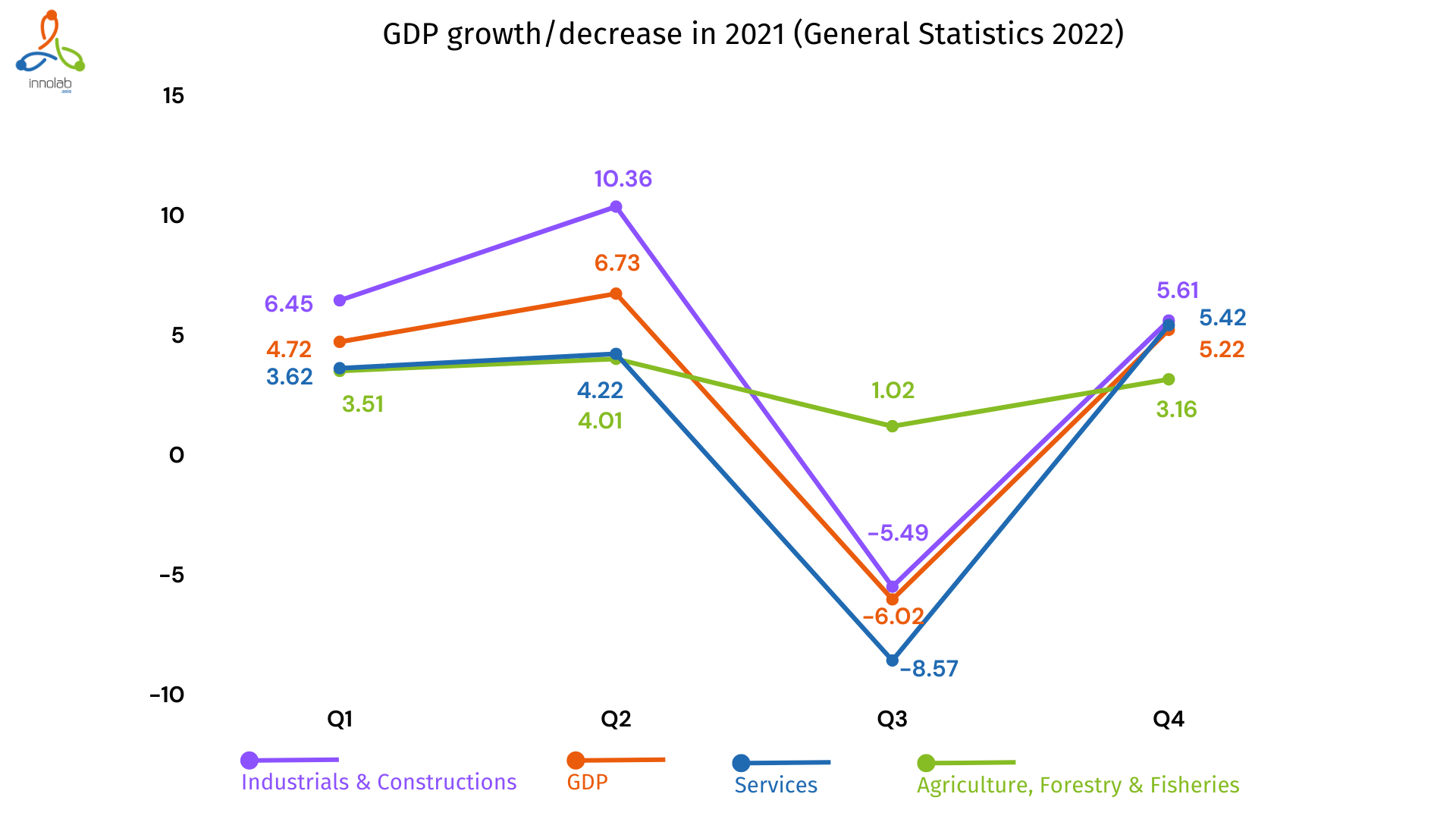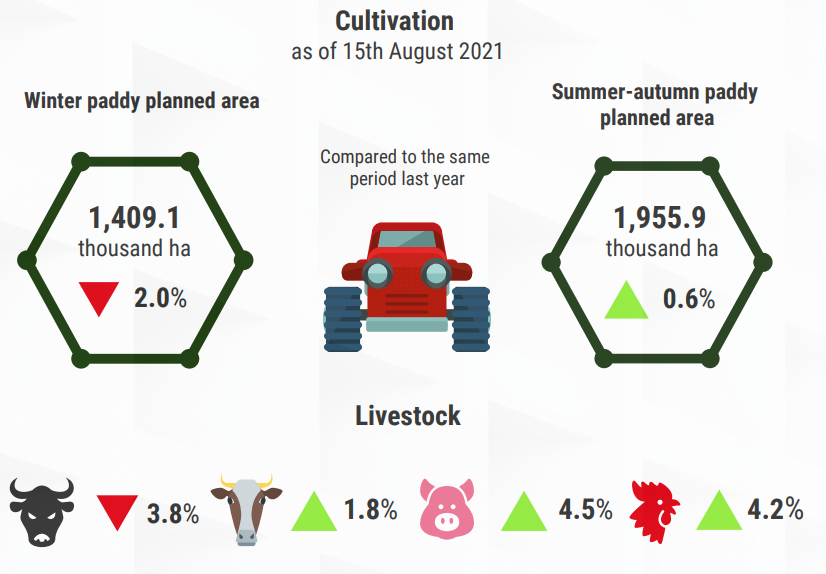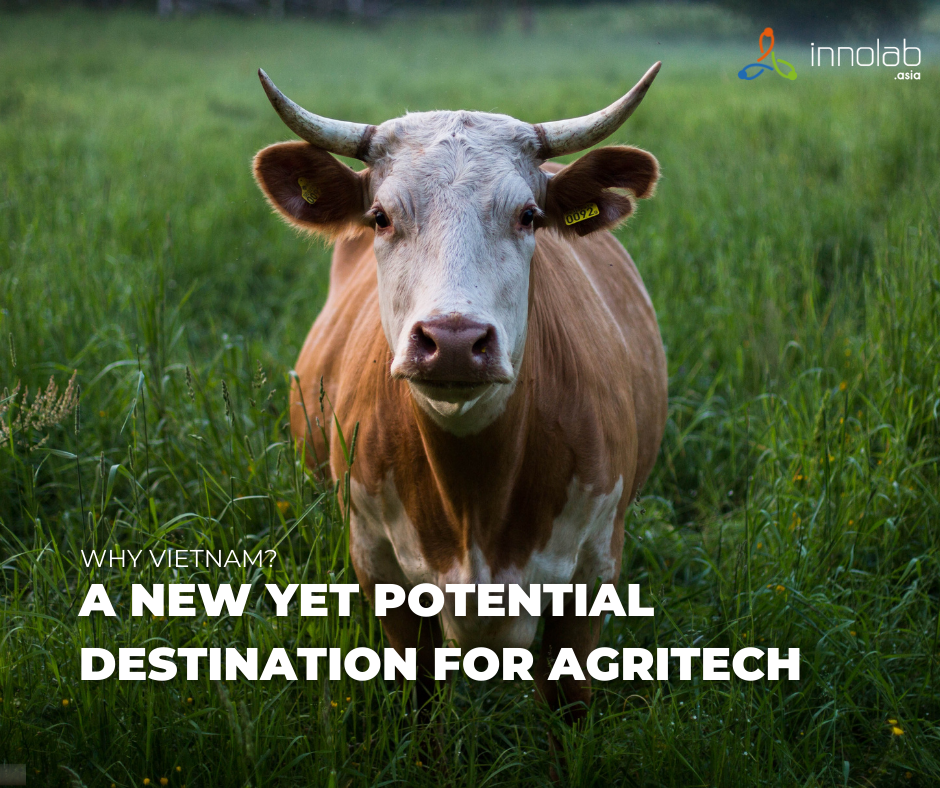Why Vietnam?
A new yet potential destination for AgriTech
Overview of Vietnam’s agriculture:
In 2021, the COVID-19 pandemic has profoundly impacted all aspects of the economy, life and society, especially in the third quarter which experienced an unprecedented decline in GDP by 6.02% with the adjustment of the economy. Regardless of the difficulties amidst the pandemic, the Agriculture, Forestry and Fisheries sector emerged as one of the “supporting platforms” of the 2021 economy, achieving a growth rate of 2.9%. higher than 2.58% growth rate of the whole economy, creating momentum for the recovery and acceleration in 2022. For proactivity and flexibility in production administration, in 2021, the agricultural industry has achieved many positive results, many development targets have been met and exceeded the set plan.

Figure 1: GDP growth/decreasing rate in the quarters of 2021 (%)
(General Statistics 2022)


Figure 2: Vietnam Agriculture overview (as of 15th August 2021)
(Business Center British Chamber of Commerce Vietnam 2021)
AgriTech in Vietnam
Agritech (or Agtech) refers to the application of technology in agriculture with the goal of increasing output, efficiency, and profitability. Agtech can refer to agricultural goods, services, or apps that improve different input/output processes. Despite being an agricultural country, Vietnam’s agtech industry is still lagging behind that of other countries. In contrast, despite a huge number of small-holder farmers, Vietnam has a restricted number of agtech firms and initiatives. Specifically, according to the British Chamber of Commerce Vietnam, while there are 28 million employees in the agri-food sector, there are only 48 agritech firms in the market (Tracxn 2022). As a relatively new concept in Vietnam, especially rural areas, while technology has been incorporated into agriculture for years in more developed nations such as the Netherlands, Australia, and Israel, it is still difficult to integrate contemporary technology into Vietnam’s agricultural industry.
Notable startups include Demeter, MimosaTEK, Hachi and Sero.Ai, along with other emerging startups in AgTech. According to Tech Collective, the agricultural industry in Vietnam is booming and can anticipate new agricultural trends in the future. Vietnamese agricultural technology startups have been exploiting innovative directions to transform farming methods. They are also looking to expand to other countries in Southeast Asia. There is also a collaboration between corporates and startups which are Viettel Corporation and Nextfarm, Intel Corporation and Demeter. In addition to startups collaboration, cooperation between farmers and enterprises via contracting proves to be an increasing and favorable trend (Department for International Trade 2019). AgTech also received intensive support not only from the government but also global interests and associations.
Vietnam’s progress in AgriTech:
In Viet Nam’s digital agriculture, private firms prove to be continuous primary solution creators. VinEco, Hachi, TH True Milk, Vinamilk, Agrimedia, GreenCoffee, MimosaTEK, BacTom, RTAnalytics, Fsoft, TraceVerify, and the Digital Agriculture Association of Vietnam are among the most notable companies. Public-private collaborations have aided in the advancement of digital agriculture innovation. The International Rice Research Institute, SwissRe, Sarmap, the German Society for International Cooperation, and the Swiss Agency for Development and Cooperation collaborated on the remote sensing-based Information and Insurance for Crops in Emerging Economies (RIICE) project to deliver advanced technologies to low-income farmers who would otherwise be unable to access them. In 2017, Google, in conjunction with the VietNam Farmers’ Union (VNFU), launched a program to improve farmers’ digital skills by employing 40 trainers and 500 support workers to deliver training to at least 30,000 farmers in nine provinces by 2020.
Opportunities & Challenges:
Despite the relatively new concept, in terms of developing effective policies and incentives, diverse government agencies and stakeholders have made considerable commitments to the transition to new digital agriculture services. Viet Nam has created expanded regulatory frameworks that promote digital agriculture throughout the last two decades, although through fragmented policies and authorities. Notably, decision No.749/QĐ-TTg dated June, 2020 prioritizes agriculture as one of eight sectors for digital transformation (Chinhphu.vn 2020). Besides, in February 2021, a restructuring plan for agriculture towards 2021-2025 is approved for the development of a modern and sustainable agriculture associating it with the global value chain. Besides, the State Bank of Vietnam and other banks offer a financial package worth 100 trillion VND ($4.37 Billion) to leverage hi-tech agriculture business.
Over the years, the agricultural industry has also paid more attention to digital transformation solutions and applying technology to most areas of the industry. Up to now, most of the basic digital technologies in agriculture have been deployed or started to be tested in Vietnam such as Big Data, IoT, etc. According to the Digital Agriculture Profile of Vietnam (FAO 2021), Viet Nam has created a solid basis for digital agricultural solutions, and the ecosystem surrounding digital agriculture is constantly expanding. Because of affordability, accessibility, and strong government backing, connectivity and subscription rates are high. A number of digital agricultural technologies have had substantial success. With the trend of increasingly using digital technologies, Vietnamese agriculture is gradually transforming from traditional agriculture to modern agriculture. Moreover, AgriTech emerges as a relatively new sector which allows prolific space for developments and few competitors. (Figures and Events Review of the GSO 2021).
In addition to the achieved results, the process of agricultural digital transformation in recent years still has difficulties such as: Low level of mechanization, auxiliary technologies for agricultural development (mechanization, processing, etc.) deep processing, agricultural product testing lines…) are not adequate; small cultivation area; forecasting output of agricultural products is still mainly based on experience; agricultural enterprises have not invested much in digital transformation; the quality of human resources with high expertise in digital agriculture is still limited; Farmers’ awareness and skills in using digital technology are not high (Figures and Events Review of the GSO 2021).
Regarding legal aspects, while the Vietnamese government has favorable laws and regulations to encourage the use of high technology in agriculture, international enterprises may confront a number of challenges. The first challenge is the time it takes to import supply chains and equipment into Vietnam. The second issue is a lack of openness in incentives, environmental rules, and agricultural input and output management. This creates difficulties for international enterprises who want to develop into Vietnam and must negotiate their strategy. Moreover, Vietnam must create a more sustainable ecosystem to assure national food security and agricultural product quality. This demonstrates the need for more sustainable methods and non-toxic, environmentally friendly new technology.
REFERENCES
BritCham 2021, Vietnam Agritech Report, viewed 12 April 2022, <https://britchamvn.com/wp-content/uploads/2021/09/Agri-Tech-Sector-Report.pdf>.
Chinhphu.vn 2020, Phê duyệt ‘Chương trình Chuyển đổi số quốc gia đến năm 2025, định hướng đến năm 2030’.
Department for International Trade 2019, Vietnam Agritech Report, viewed 12 April 2022, <https://www.ukabc.org.uk/wp-content/uploads/2019/07/Agritech-Sector-Update-April-2019.pdf>.
Figures and Events Review of the GSO 2021 2021, Vai trò của người nông dân trong chuyển đổi số nông nghiệp, consosukien.vn, viewed 12 April 2022, <http://consosukien.vn/vai-tro-cua-nguoi-nong-dan-trong-chuyen-doi-so-nong-nghiep.htm>.
General Statistics 2022, Tăng trưởng khu vực Nông, Lâm nghiệp và Thủy sản bệ đỡ cho nền kinh tế và ‘tấm nệm’ cho công tác an sinh xã hội năm 2021, General Statistics Office of Vietnam, viewed 12 April 2022, <https://www.gso.gov.vn/du-lieu-va-so-lieu-thong-ke/2022/01/tang-truong-khu-vuc-nong-lam-nghiep-va-thuy-san-be-do-cho-nen-kinh-te-va-tam-nem-cho-cong-tac-an-sinh-xa-hoi-nam-2021/>.
Tracxn 2022, AgriTech Startups in Vietnam, tracxn.com, viewed 12 April 2022, <https://tracxn.com/explore/AgriTech-Startups-in-Vietnam>.



